| Manufacturer: | Scratch |
MIB - Flying Gold Cone
A SciFi Comedy Spaceship Kitbashed from a FlisKit and flying on one or two MicroMaxx Motors
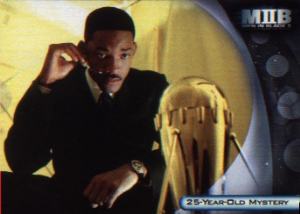
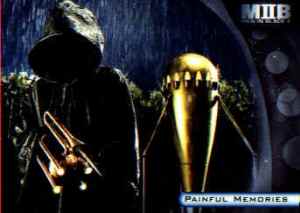
 I decided to build a Comedy Sci-Fi Rocket from Men In
Black II. The ship in question is the gold chromed ice cream cone shaped
vessel. It figures prominently in the opening "news reel" sequence as
a recreation of eye witness accounts. The ship heads back to Earth early in the
film. It is shown passing through space and wielding immense destructive power.
The flying cone crashes to Earth in an apparently immense plume of dirt. We
discover the true size of the ship when a small dog investigates it after the
ship crashes in a park.
I decided to build a Comedy Sci-Fi Rocket from Men In
Black II. The ship in question is the gold chromed ice cream cone shaped
vessel. It figures prominently in the opening "news reel" sequence as
a recreation of eye witness accounts. The ship heads back to Earth early in the
film. It is shown passing through space and wielding immense destructive power.
The flying cone crashes to Earth in an apparently immense plume of dirt. We
discover the true size of the ship when a small dog investigates it after the
ship crashes in a park.
My recreation of the MIB Flying Gold Cone was built in approximately 1:6 scale, so that it can be displayed with a kitbashed MiB action figure I created. With that as a goal, it was important to preserve/restore the cone shaped nature of the ship while on display.
The only structural elements not from the FlisKit are pieces of a Bic Round Stick pen used as engine mounts and launch lug, an expended MicroMax engine used in creating a cluster adaptor, and a piece of threaded rod used to weight the nosedome.
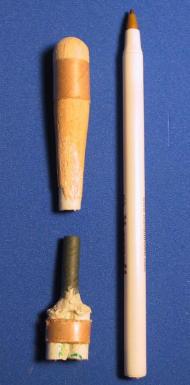
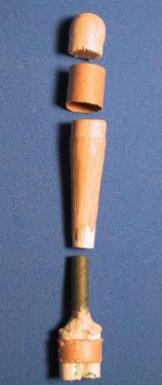 I fashioned the lower cone from the large nose cone. I
drilled it out and inserted some BiC stick as an engine mount. Small diameter
body tube serves as an engine block and ejection gas conduit. A shorter
nosecone was sanded to fashion the nosedome. This was drilled out and a
threaded rod inserted to weight the nose. A small section of body tube serves
as the coupler between the two nosecones. A section of the kevlar thread from
the FlisKit connects the two nosecones together.
I fashioned the lower cone from the large nose cone. I
drilled it out and inserted some BiC stick as an engine mount. Small diameter
body tube serves as an engine block and ejection gas conduit. A shorter
nosecone was sanded to fashion the nosedome. This was drilled out and a
threaded rod inserted to weight the nose. A small section of body tube serves
as the coupler between the two nosecones. A section of the kevlar thread from
the FlisKit connects the two nosecones together.
I fashioned the bent legs by steaming the stick stock from the FlisKit and hand forming the desired shape. These are glued into holes hand drilled into the upper end of the main body.
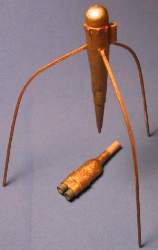 I created a cluster adaptor that allows two MicroMaxx
motors to be attached to the single MMT in the lower cone. I did this by
bonding two Bic stick sections together and bonding a spent MMX casing between
the bonded MMTs. The Bic plastic was heat formed around the MMX casing to
direct the ejection charge gasses from both lower engines up into the spent
casing. The cluster adapter is used by inserting the spent MMX casing into the
main MMT. The threaded rod in the upper nosedome allows the installation of
extra balance weight when the lower engines are installed.
I created a cluster adaptor that allows two MicroMaxx
motors to be attached to the single MMT in the lower cone. I did this by
bonding two Bic stick sections together and bonding a spent MMX casing between
the bonded MMTs. The Bic plastic was heat formed around the MMX casing to
direct the ejection charge gasses from both lower engines up into the spent
casing. The cluster adapter is used by inserting the spent MMX casing into the
main MMT. The threaded rod in the upper nosedome allows the installation of
extra balance weight when the lower engines are installed.
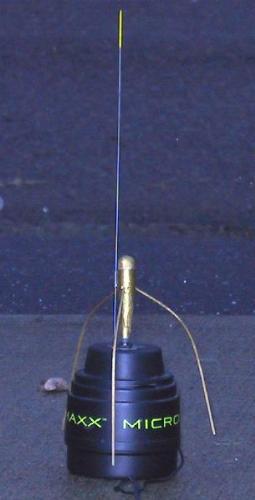 To restore the cone tip for display I created a
display tail from a small nosecone and body tube found in the FlisKit. The tail
fits into the main MMT and provides the pointy end for the cone when it is on
display.
To restore the cone tip for display I created a
display tail from a small nosecone and body tube found in the FlisKit. The tail
fits into the main MMT and provides the pointy end for the cone when it is on
display.
I painted the entire assembly with gold acrylic using a brush. Not stylish, but sufficient for this scale.
The single engine configuration can be launched on a standard MicroMaxx launcher. I epoxied a small section of Bic pen inktube to the bodytube to serve as a MMX launchlug. I launched the MIB Flying Gold Cone on a single engine. It flew flawlessly, with a stable flight up to about 50 feet. The ejection charge separated the nosedome rather early (as is often the case with MMX motors). The resulting non-aerodynamic configuration quickly slowed and tumbled down to land about 15 feet from the pad. A perfect backyard flier.
The MIB Flying Gold Cone features a handrolled paper launch lug for use on a MMX launchpad. This replaces an earlier version made from a BIC Pen ink tube. Also included is a standard launch lug as found in the FlisKit Grissom kit. Multiple small lengths of stick stock from the FlisKit were added just below the nosedome separation point. These were carved, sanded, and painted to approximate the design details from the movie version of the ship.
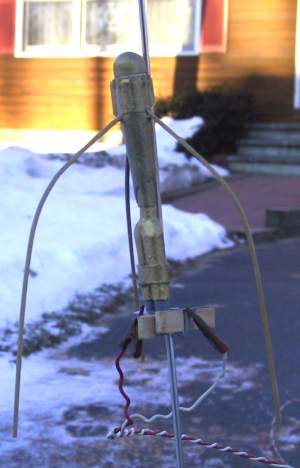 The MMX cluster adapter was also refined. The initial
implementation, using BIC barrels and expended MMX was set aside. A lighter
version was fashioned from glue soaked rolled paper and a small diameter body
tube from the FlisKit. The design is the same, with two side by side MMTs
venting into a single central tube that fits into the main MMT. By soaking the
upper paper in yellow glue, I was able to mold it to transition smoothly into
the central body tube.
The MMX cluster adapter was also refined. The initial
implementation, using BIC barrels and expended MMX was set aside. A lighter
version was fashioned from glue soaked rolled paper and a small diameter body
tube from the FlisKit. The design is the same, with two side by side MMTs
venting into a single central tube that fits into the main MMT. By soaking the
upper paper in yellow glue, I was able to mold it to transition smoothly into
the central body tube.
The first attempt at a MIB Flying Gold Cone cluster flight met with mixed results. I fashioned a dual MMT cluster ignitor out of a length of nichrome wire. A small square of tabe was used to hold the the filament in each nozzle. The rocket was balanced on a clothespin to keep the igniter leads up off of the standard Estes Portapad blast plate. When the wire leads were touched to the 14V cordless drill battery, the MIB Flying Gold Cone struggled up off the pad, arced over about 15 feet off the ground, and ejected its nose just before sinking into the snowy yard. No damage was done. Upon inspection, it was obvious that only one engine ignited, though both ignitors burned through. I suspect one filament may have slipped away from the propellant.
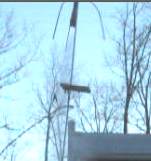 Review of a digital launch video shows the rocket
leaping almost out of frame between one image and the next. The rocket then
lingers, dancing at the top of the rod, for three more images. I believe the
uneven thrust, coupled with the single high mounted launch lug, caused the
rocket to bind on the rod, and have insufficient speed for stability as it
cleared the rod. I have made a design change to the MMX Cluster Adapter that
should address this in future flights. I added a launch lug on the binding ring
of the Cluster Adapter. The pair of lugs should help guide the rocket up the
rod if one of the engines fails to fire.
Review of a digital launch video shows the rocket
leaping almost out of frame between one image and the next. The rocket then
lingers, dancing at the top of the rod, for three more images. I believe the
uneven thrust, coupled with the single high mounted launch lug, caused the
rocket to bind on the rod, and have insufficient speed for stability as it
cleared the rod. I have made a design change to the MMX Cluster Adapter that
should address this in future flights. I added a launch lug on the binding ring
of the Cluster Adapter. The pair of lugs should help guide the rocket up the
rod if one of the engines fails to fire.
Sponsored Ads
 |
 |











